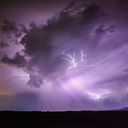Climate whiplash: Southwest swings from drought to flood

Nearly all of Arizona and New Mexico are under flood watches today, as moisture from the southwest monsoon surges northward.
Threat level: The storms, which are a part of a seasonal pattern that is unusually active this year, are expected to cause widespread flash flooding, debris flows and other hazards.
- These hazards may affect both desert landscapes and major cities such as Phoenix and Las Vegas, according to the National Weather Service (NWS).
- Already this monsoon season, the Las Vegas strip has flooded, and roads have been washed away in Death Valley National Park — a location known for its sizzling temperatures, not flooding rains.
- The NWS' Weather Prediction Center has taken the relatively rare step of issuing a "moderate" outlook for excessive rainfall in the Southwest on Friday and Saturday. This is a level 3 out of 4 on its alert scale.
The big picture: Moisture flowing north from the eastern Pacific is interacting with upper-level weather disturbances to pose the threat of more than an inch of rain falling in a short period of time.
- The drought conditions, which have eased some, will make it difficult for the ground to absorb the moisture, leading to flash flooding.
- In a forecast discussion, the NWS cited unusually high levels of atmospheric moisture moving into the region, with an up to 70% chance for locations to exceed a 10-year rainfall event.
- That increases to 90% probability by Saturday, as the heaviest rains shift east into New Mexico and western Texas.
What they're saying: The NWS forecast office in Phoenix isn't pulling any punches Friday, stating: "The forecast remains on track with the potential for one of the larger rainfall events so far this Monsoon season." Forecasters also called the plume of moisture in place over the region, "massive."
- The Weather Service forecast office in Albuquerque is warning of flash flooding in areas with burn scars from recent wildfires. Such landscapes have little vegetation to help absorb falling rain, and can quickly lead to fast-moving, downhill flows of water, mud and other material.
Context: Climate change from the burning of fossil fuels is causing an increase in the instances of heavy precipitation events across the U.S. and the world, studies show.
- However, increases in heavy downpours have been most pronounced in the Midwest and Northeast, though that may be due to the larger sample size in this region.
- Climate change has helped trigger and worsen the 23-year megadrought in the Southwest, and exacerbate the extreme heat and drought in Texas this summer.
What's next: Texas has endured a record warm, dry spring and summer, but that may be set to change this week. For the first time in months, forecasts are calling for several inches of rain to fall across much of the Lone Star State.
- This is related to the monsoon, but also to a shift in the overall U.S. weather pattern that will bring the jet stream farther south than it has been located for most of the summer.